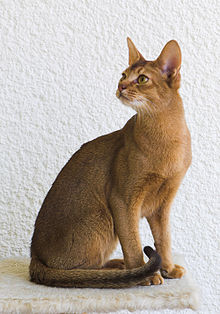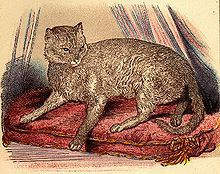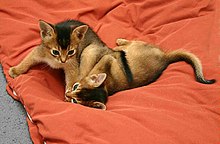Abyssinian cat
| Abyssinian | |
|---|---|
 | |
| Origin | coast of Indian Ocean[1] |
| Breed standards | |
| CFA | standard |
| FIFe | standard |
| TICA | standard |
| ACF | standard |
| ACFA/CAA | standard |
| CCA-AFC | standard |
| Domestic cat (Felis catus) | |
The Abyssinian (Pronunciation: /æbəˈsɪniən/) is a breed of domesticated cat with a distinctive ticked coat. There are many stories about its origins, often revolving around Egypt, but the actual origins are uncertain. The Abyssinian has become one of the most popular breeds of shorthair cat in the USA.[2]
History

The name 'Abyssinian' refers to Ethiopia, but most of the stories about the origins of Abyssinians refer to Egypt. Genetic research suggests the breed originated near the coast of the Indian Ocean, where colonists may have purchased animals from wild animal traders. The breed was developed in the United Kingdom.[3]
The breed is sometimes believed to have originated from one Egyptian female kitten named Zula, who was taken from a port in Alexandria by a British soldier and brought to England. This theory is not established because there is no solid link between Zula and the cat first listed as an Abyssinian in 1882.[4]
Many sources repeat the story that the Abyssinian breed is a few thousand years old and comes from Ancient Egypt, as the cats resemble those in ancient paintings. There are also stories that wild 'Abyssinians' live in parts of North Africa today.[citation needed]
Physical characteristics
The Abyssinian's body is of medium length, lithe, and with well-developed muscles. The legs are slender in proportion to the body, with a fine bone structure. The paws are small and oval. The Abyssinian has a fairly long tail, broad at the base and tapering to a point.
The head is broad and moderately wedge-shaped, with almond-shaped eyes that range from gold, green, hazel or copper. The nose and chin usually form a straight vertical line when viewed in profile. The Abyssinian's alert, relatively large ears are broad and cupped at the base, and moderately pointed at the tips, where tufts of hair are commonly seen. Large ear tufts are viewed as a must for show breeds. An M-shaped marking is sometimes found in the fur on the forehead. [4][5] The "M" shaped marking, also referred to "frown lines", appear above an Abyssinian's eyes. [5] They have markings, most often referred to as "mascara lines", appearing from the corners of their eyes.
Coat types and genetic makeup

The coat is medium-length, dense, and silky to the touch. The Abyssinian, and a similar long-hair breed called the Somali, have coats that are unusual enough to catch attention. These felines owe their special coat to one dominant mutant gene known as Ta. Each hair has a base color with three or four darker-colored bands; the hair is the lighter color at the root, and the darker "ticking" color at the tip. The Somali and Abyssinian are the only types of cats that have the Ta gene, and thus are the only breeds featuring this special ticking.[4]
The first cat to have its entire genome published was an Abyssinian named Cinnamon.[6]
The original Abyssinian coat colour is known as 'Usual' in the United Kingdom and as 'Ruddy' elsewhere. The coat has a warm reddish-brown base, with black ticking. The feet and the backs of the hind legs are always black.
Over the years, various other colours have been developed from this original form, but the markings on the coat have remained the same. The back of the hind legs and the pads of the paws are always darker than the rest of the coat. A popular colour is Sorrel, which has a cinnamon (yellowish-brown) base, with chocolate brown ticking, paw pads and backs of the legs. Blue Abyssinians, which have become increasingly popular in recent years, have a light beige base colour with blue ticking, paw pads and backs of the legs. The relatively rare Fawn Abyssinians have a light-cream base colour, with darker cream ticking and warm dark cream pads and backs of the legs.

Silver Abyssinians are a separate group among the breed. Although this colour has been in existence for decades, it is not recognised by the Cat Fanciers' Association, the world's largest registry of pedigreed cats. In Silvers, the undercoat is always a pure silvery white. The markings include black, blue, warm dark cream and cinnamon. Purely Silver Abyssinians are difficult to breed because they sometimes have undesirable tan patches in the coat. In addition to this, any spots in the coat show up more clearly on a silver coat.
Rare colours include the Tortoiseshell, Red, Cream, Chocolate and Lilac, which are all bred on a small scale in Holland and the UK.
Abyssinian kittens are born with dark coats that gradually lighten as they mature. It usually takes several months for the final coat colour to be established.
Temperament

Abyssinians are extrovert, willful and intelligent, but are usually not "lap cats", being too preoccupied with exploring and playing as they would in their natural habitat. Although very popular among breeders and owners, Abyssinians are not often shown, because of their shyness towards strangers and their timid nature. They have quiet, engaging voices that can often be misleading.
"Abys", as they are affectionately referred to by their fans, need a great deal of contact with the family to keep them happy and can get depressed without daily activity and attention.[4] They generally get along well with other cats, although they need their space and the females can sometimes be irritable around other cats. Abyssinians are known for their curiosity and enjoy exploring their surroundings, including heights. They are sensible cats that do not take unnecessary risks. As one might expect from such an intelligent and physically capable breed, Abyssinians are known to be formidable hunters.
References
This article needs additional citations for verification. (April 2008) |
- ^ "Abyssinian Profile", Catz Inc., accessed 4 Oct 2009
- ^ Cat Fanciers' Association. "Breed Profile: Abyssinian". 2008.
- ^ "Abyssinian Profile", Catz Inc., accessed 4 Oct 2009
- ^ a b c d Pollard, Michael. The Encyclopedia of the Cat. United Kingdom: Parragon Publishing, 1999.
- ^ a b Fogle, Bruce. The New Encylopedia of the Cat.
- ^ Highfield, Roger (2007-10-31). "Cinnamon the cat could offer hope to the blind". The Daily Telegraph. Retrieved 2007-11-01.
{{cite news}}: Check date values in:|date=(help)
